
Sunshine in a Time of War: Palliative care and cancer care in Sudan
![]() Cairdeas
Cairdeas
![]() 12th March 2024
12th March 2024
This blog was submitted by Dr Nahla Gafer, our Cairdeas IPCT lead for palliative care in Sudan.
Almost a year ago, all our worries at the palliative care unit were how to establish home care in a systematic way as to be available to all patients nearing the last phase of their lives. The palliative care unit was formed of volunteers working at the main oncology hospital in the country. The unit had (by then) completed 13 years since its initiation and had established an outpatient clinic with > 50 patients coming twice a week, in addition to the inpatients and the home care visits.
No one had expected a war, and our world was turned upside down. I was worried about my colleagues, family, and friends but I was more worried about my patients. GA is a 35-year-old lady with a devastating vulval tumor. She cannot sit straight; in public transport she needs to lie on her side. Her pain was controlled by 6 tablets of 15 mg of morphine every 4 hours. We reached a point of convincing her to try a mild chemotherapeutic agent, after her last chemotherapy treatment, which was 2 years ago, and during which she had severe side effects, and was very reluctant to go back to chemotherapy. At last, we had a promise from her to try this mild chemotherapy after Eid. Then the war came.
AK had multiple ulcers from his squamous cell carcinoma, now running havoc all over his face, neck, back, limbs, etc. It did not help at all that he was albino, and my role was not only to find alternative ways to reduce the disfiguring masses and control the oozing and pain, but also to support him, and help tackle his psychological and social issues. OA is a lovely girl of 12, being informed by her attending physician, that nothing more can be done for her, her mother came to the unit seeking support. Building up her general condition and managing her pain, she was back on tract on active treatment with good response. She went on to speak on breast cancer month, to schoolgirls her age saying that the disease is a test to her faith, and that endurance brings one nearer to God. She thanked her family and treating physicians and really showed how one can really be so strong in spirit inside a weak body. For some months after the war, we lost contact.
Those are a few of almost 1,000 patients we were serving when the war broke out. The first priorities once the war started was to go to a safe area and ensure you have food. There are certain things that are already lost: your property, house, furniture, car, office, whatever you previously had, and your source of income. All forms of normal life, including work, stopped; the internet was so weak that a message sometimes takes a week to get through, and our local internet banking was not functioning. After this was sorted out, we were still so worried about our patients and about our colleagues.
The international community stood by us, and through donations, we were able to mobilise our colleagues and their family members outside of the hot conflict areas. A plan was set with Cairdeas International Palliative Care Trust (Cairdeas IPCT) and SANAD The Home Hospice Organization of Lebanon, to support the team members, some of whom had remained in war zone areas for 3 months. We then created “Sunshine in a Time of War,” a project by Cairdeas IPCT and SANAD The Home Hospice Organization of Lebanon aimed at supporting the palliative care unit. Even before the project was implemented, just the idea that you matter to someone and that someone is ready to help, gave the team members a lot of strength.
Sunshine in a Time of War holistically supported the palliative care team in Sudan. Psychological support to the members of our palliative care unit was very important, and we needed to provide debriefing and psychological first aid (PFA) training. This resulted in multiple contacts with team members from those from SANAD The Home Hospice Organization of Lebanon, who assessed how they were doing, providing debriefing and referral to local services for psychological support, as well as offered training through a video series posted on YouTube. Financial support to the team was also essential, which included providing for their phone and internet assess while working as well as supporting their salaries, organised by Cairdeas IPCT. [Many thanks to the generous supporters and friends of Cairdeas IPCT, who played a large role in supporting our palliative care colleagues in Sudan!]
During the Sunshine in a Time of War project, we faced several challenges. For example, no one could reach the hospital, where we had the computer with all patients’ data, their contacts and their family members contacts. We had to find another way to reach the patients as soon as possible and as many as possible. We collected all numbers we previously had in our smart phones, especially from the nurse who was had the habit of calling patients the second day following on their pain medications. The team members started reaching out to patients through telephone calls, WhatsApp and messenger text and voice messages. The main purpose was to check on their security, advise them with practical issues, as well as check on their disease and what to do about it.
More than 400 patients were reached, all documented nicely in ledgers kept in a make-shift office, in a remote city, in the north. We made sure to record the diagnosis, time of diagnosis, stage, previous anticancer treatment received, current complaints and current situation. The 10 years of work at the palliative care unit made our team very competent in palliative care and in oncology, especially in managing all problems: physical, psychological, social, and spiritual. At times, when there was need for further consultation, myself and another two doctors were reachable by WhatsApp. The palliative care unit were also able to contact SANAD The Home Hospice Organization of Lebanon, for psychological support for themselves, the patients and their families. While the palliative care unit no longer existed as a physical place, it turned into a virtual network connecting 400 patients with 8 Sudanese staff and 4 Lebanese staff, supported by Cairdeas IPCT and SANAD The Home Hospice Organization of Lebanon.
The amount of support we could give to the patients remotely is amazing. Even end-of-life care was conducted remotely. KA had liver metastasis that affected his liver function, but the family was not aware how terminal he was. A series of calls to the family was very helpful in exploring his current complaints, checking the signs of eminent death (examining the mouth ulcers, other complaints, etc.), explaining what was beneficial and what is not through family meetings conducted with the family members in a separate room, and the camera directed to the person who was speaking. Yes, it is possible to conduct virtual family meetings as well as virtually assessing symptoms, discussing with the patient, directing, and even prescribing medications. (Prescriptions were written, photographed, sent by WhatsApp to the family.)
We received several messages of thanks and gratitude from the patients and their family members. Yes, we helped them, they needed us, but also, we needed to preserve the work that we had started; we needed to help our patients. It is part of who we are. This way we are really healing, caring and humane health professionals.
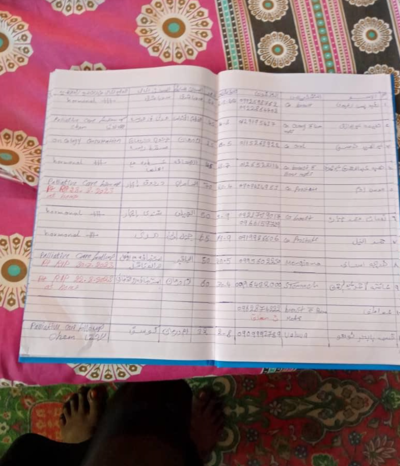
Record-keeping is now pen and paper, WhatsApp photos and chats when possible.
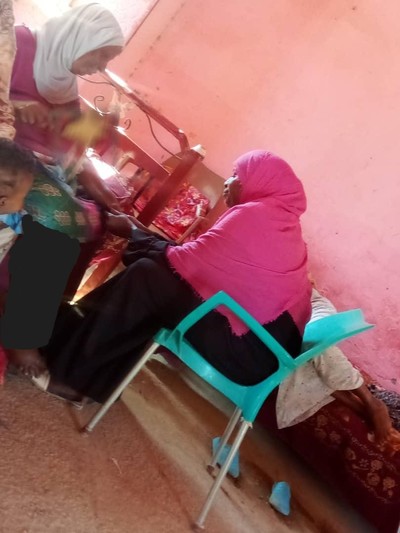
A picture taken during a home visit in Sudan, although it has been rare to see patients in person.
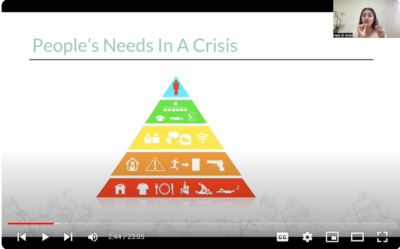
Training for Psychological First Aid was completed virtually through a video series for the palliative care unit, from SANAD.

Notes for patients are collected and photographed to share with the doctors, like Dr Nahla Gafer. This is a summary of patients seen by Nurse Mahasin in November 2023.

The palliative care unit continues to care for patients and families, even during this time of war.
‘Inspire, Empower, Influence and Transform:’ Compassionate Leadership Fellowship update
![]() Hannah Ikong
Hannah Ikong
![]() 11th March 2024
11th March 2024
As palliative care providers, leadership development is key to building our teams and expanding our reach in healthcare provision. Even more so, compassionate leadership development touches on the goals of palliative care to reduce suffering, promote dignity, fight for justice and improve quality of life.
Compassion is a paradigm we speak of in relation to our work with those needing palliative care but what about the focus on how we lead, how our organisations are run, and how we bring forward the next generation of colleagues. Thus our focus is on holistic personal transformation in order to transform our settings and increase our influence.
The Compassionate Leadership Fellowship (CLF) has been made possible by partners Believers Church Medical College Hospital (BCMCH), Cairdeas International Palliative Care Trust (Cairdeas IPCT), Global Health Academy, University of Edinburgh (UoE), the Indian Association of Palliative Care (IAPC), and RMD Trust. We are also grateful for previous opportunities internationally for many involved including the LDI programme (thanks Frank Ferris) and innovative programmes in India and Uganda that helped shape our CLF.
In its structure, the CLF is taught using a blended learning modular format. Modules 1 and 3 are six days held in person at BCMCH in Thiruvalla, Kerala. These modules bookend Module 2 which has monthly online sessions. In addition to the taught sessions the CLF has a mentorship programme which is key to the transformational learning design. We are fortunate to have experienced mentors who attend all the training events as well as work on to one online. They have also committed to visiting each Fellow at their place of work.
February 18th of 2024 marked the official beginning of the CLF with an inauguration ceremony of music, prayers, and calls to compassionate care and leadership in the healthcare systems of India and beyond. We were proud to commence the first CLF cohort with 19 Fellows (16 from across India and 3 others from Rwanda, Kenya, and Nepal) and 13 Mentors, and great support from all partners involved.
The programme’s co-chairs, Prof Chitra Venkateswaran of BCMCH and Dr Mhoira Leng from Cairdeas IPCT, reminded us of the connection of previous leadership development programmes and our future to strengthen even more leaders in palliative care. We welcomed videos from our partners nationally and internationally with a warm reception from our hosts BCMCH.
The first in-person module (February 19-24, 2024) allowed us to explore the characteristics of leadership and understanding oneself as a leader. We are using the widely recognised Leadership Development Index which offers 5 exemplary characteristics for effective leadership. We explored these together including our personal integrity, how we inspire and enable others, how we effectively challenge and support change and how we do this within a compassionate supportive environment. There was plenty to reflect on and learn even for the ‘experts.’ Our Fellows used a creative approach to present “Who am I as a Leader,” helping us get to know each other but also establish our leadership strengths and areas for growth.
A core aspect of leadership development is self-awareness, so we utilised tools with expert facilitation and then added group work, activities, and self-refection to help deepen our understanding of ourselves and how this impacts others. For example, the Myers Briggs Type Indicator gives insight on how we re-energize, interpret the world around us, make decisions and order our world. The KELP tool explores our preferred learning style, and we will use these foundational tools during the whole CLF programme to support our fellows in teaching, leading teams, and negotiating with others more effectively.
Our time together in February 2024 culminated in a leadership development plan (LDP) which Fellows will finalise in sessions with their Mentor. In addition to planning for personal development, the Fellows are agreeing to plan leadership activities that follow the S.M.A.R.T.P.A. guidelines (i.e., Specific, Measurable, Attainable, Relevant, Time-bound, Person-responsible, and including Accountability.)
We look forward to the ongoing interactions and growing bond between each Mentor and Fellow, as they journey through transformational compassionate leadership development and as we together form a crucial community of practice. We now embark on monthly teaching session online covering topics such as strategic planning, team building and dynamics, organisational development, teaching, and research, supported by national and global experts.
Our fellows have shared feedback already, so early in the CLF programme. After the first in-person module together, fellows took turns to write and share the following:
“It was a wonderful, fantastic self-introspective workshop. Really enjoyed the way it was scheduled and conducted.”
“Here is a heart filled with gratitude to our Organizers and Mentors. Trust and fun filled new friendships. Experienced, learned and grew more than I ever expected. Here’s a changed me to Model the way, Inspire, Enable others, Challenge and Encourage the hearts.”
“Just wrapped up an amazing workshop. Great learnings and looking forward to more. Thank you all.”
“Thanks to Dr Chitra, Dr Mhoira, Dr Leejia and all those involved in careful planning and execution of 1st CLF ever. It was a great learning experience. My take home message is not to waste our energy on things we can’t change. Instead concentrate on what we can change … not to forget my mentors … all of you who will have a hand in a changed ME.”
As we look to the months ahead, there is transformational growth in our journey together from knowing who we are as a leader to becoming changemakers in compassionate care. The CLF is not in the numbers only of 19 fellows with 13 mentors, interlocking 6 countries in 2 in-person sessions, 10 online sessions, and over 190 mentorship meetings. Rather, there is boundless impact through this compassionate leadership development, in ourselves and for our teams and health systems, our patients and their families.
Quality palliative care for all is comes from the development of compassionate leaders, and now that we have begun, the sky is the limit.

Group photo of fellows and mentors in the CLF programme; in front centre sits Dr Mhoira Leng, Dr George Chandy of BCMCH, and Dr Chitra Venkateswaran.
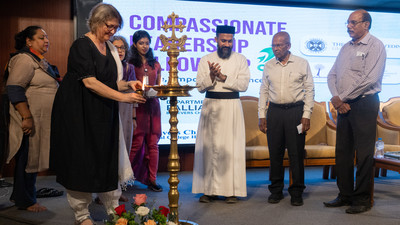
Inauguration ceremony involved each partner representative lighting the flame at BCMCH.
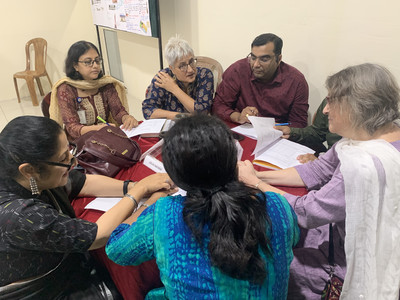
Small group discussions were key during the CLF, as mentors sat with their fellows during the programme.
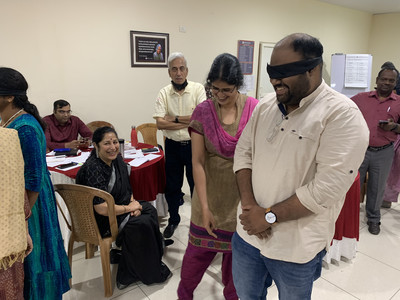
Classroom activities included individual and group presentations, role plays, and other activities to help visualise the taught concepts.

A lovely afternoon in on the Backwaters of Kerala, India brought sessions of Encourage the Heart, shared leadership journeys, and times to connect and grow as a group.
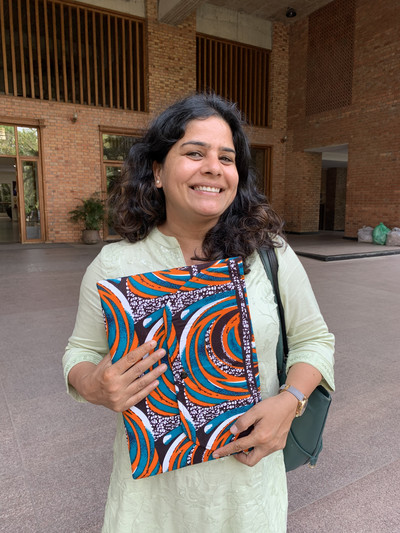
A tangible key takeaway; kitenge document folders were hand sewn and sent from Uganda; a daughter of one of the PcERC team members made excellent materials for the CLF programme.

We look forward to reuniting online, and our next CLF programme in February 2025!
Greetings from Mauritania: Dr Dave Fearon
![]() Cairdeas
Cairdeas
![]() 18th January 2024
18th January 2024
Many thanks to the blog author, Dr Dave Fearon, for his update from Mauritania; an arm of "Cairdeas Sahara."
Mauritania is positioned as a bridge between North and West Africa, bordered by the Sahara Desert on the east and the Atlantic Ocean on the west. It is a very large country but much of it is desert and one million, a quarter of the population, live in the coastal capital, Nouakchott. Mauritania is a lower middle-income country with much poverty visible throughout the country. Much of its healthcare provision lacks resources, both physical and personnel. Access to the available services is inequitable, with the majority of structures centralised in the capital, Nouakchott. National cancer services are only provided at the Centre National d’Oncologie (CNO) in Nouakchott, where chemotherapy, hormone therapy and radiotherapy are available to those who have managed to have their cancer diagnosed and have been referred.
Cairdeas International Palliative Care Trust has been involved in the country since 2012 when I moved there with my young family. I was involved in providing palliative care, training, advocacy and research between 2012 and 2019, after which we moved to Isle of Lewis. In Mauritania, I led a small team of nurses providing home based palliative care under the authority of a local charity. We worked closely with the CNO. We trained many of their staff including sponsoring several employees’ training at Hospice Africa Uganda and attendance at international conferences. During my stay we benefitted from a range of international visitors who came to help, especially with training. Key visitors were Dr Mhoira Leng, Dr Jaques-Antoine Pfister, Dr Silvia Dive, Dr Nahla Gafer and Dr Mohja Marhoom. The latter four visited twice, with Drs Nahla and Mohja visiting in 2023, returning home only days before the start of their home country of Sudan’s troubles.
I had the privilege of visiting for ten days in November 2023. I had very few expectations as I knew that the local charity had no plans or capacity to continue the palliative care after my leaving. I took two friends from Scotland with me, an Anaesthetist friend and financial supporter of the project, and a church of Scotland pastor from the Isle of Lewis. We had a blast and were greatly encouraged by the visible changes since 2019, all of which have been locally led and funded.
Dr Benina became the director of the CNO in 2018. From knowing her work in the paediatric oncology prior to her appointment I knew she was a special person, knowledgeable and compassion. She is very much the driving force of palliative care in Mauritania. The following points are some of the highlights from our trip:
1. New palliative care unit around 500 metres from the CNO, funded and staffed by CNO staff. Led by the lovely Dr Mohamed Elyatt, a medical doctor, and supported by the amazing nurse Aisha, both of whom Cairdeas sponsored to train in Uganda. They offer day hospice, wound dressings, out patients, social work assistance and home visits.
2. Home visits – we participated on several home visits, seeing the range of cases and social settings.
3. Spending time with two Palestinians who are known to Cairdeas from the work in Gaza. Dr Nahla arranged for them to work at the CNO after they became trapped outside of Palestine. Humbling to spend time with them on the home visits and see their passion and compassion for patients while under such pressure, fear and uncertainty about their own families. One had not received any word from his wife for several days while we were there.
4. The CNO continues to advance cancer care for Mauritania. They are more involved in training, research and they are making efforts at trying to make palliative care more integrated with cancer care.
5. We caught up with Ndiaye who was my best friend, and the local palliative care champion while I was living there. He is a very special, intelligent, kind and a very capable person. It was encouraging that his attributes have been recognised by the ministry of health, and he is now highly valued (and very well paid) by the Mother and Child Hospital. Although he is not involved in palliative care day by day, he remains a passionate advocate for it, and he is still young with a young family. I am pleased he has a job which allows him to care for his family. I hope the ministry facilitates his return to palliative care in the future.
6. We visited the ICU department at the mother and child and able to chat with the doctors about palliative care.
7. Another encouragement was the reminder that people are the same everywhere, whatever their nationality or faith. We were able to reflect on the similarities of beliefs and actions of Christians on the Isle of Lewis and Muslims in Mauritania, with their shared fears, worries and hopes.
8. Mahloud, an orderly at the CNO has been involved in palliative care for over 15 years. He started cleaning the cancer wounds and ulcers at the CNO because the nurses at that time refused to do the job because of the smell and the horrors. He has continued to care for his patients and is now an integral part of the palliative care team. During our visit he was told by the director that they are paying for him to do some preliminary nursing studies in neighbouring Senegal, which will mean more knowledge, respect and pay. Definitely my biggest smile of the trip, so well deserved.
9. I am confident in the foundation of palliative care in Nouakchott because it is funded and staffed exclusively by Mauritanians. There is still a long, long way to go, but these are undeniable positives signs of something sustainable, culturally relevant and feasible being built.

All photos are from Dr Dave Fearon; palliative care provision in Mauritania.

Masked medical team with Dr Dave Fearon (second from right).
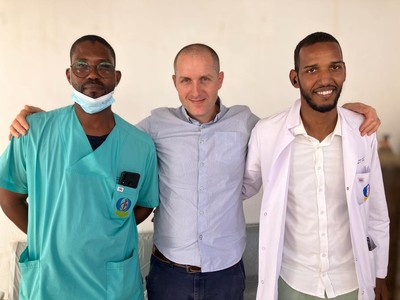
Mahloud, Dave, and Mohammed Elyatt pose for a photo.
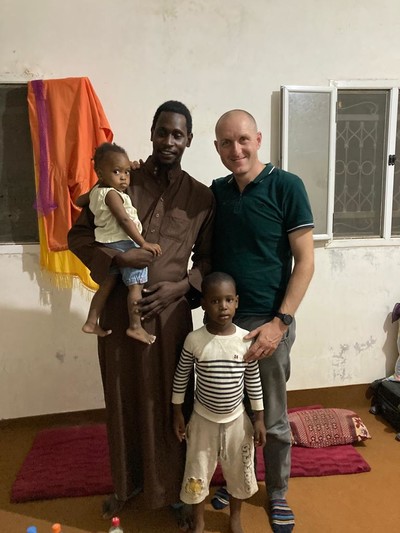
Pleased to see colleague Ndiaye and his family again.
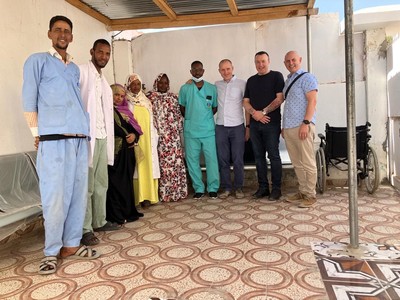
The multi-disciplinary palliative care team!
